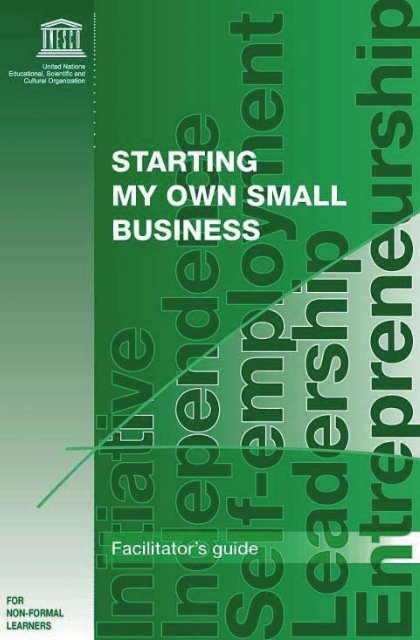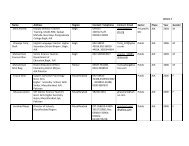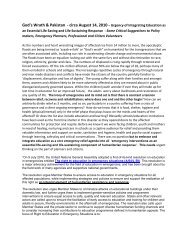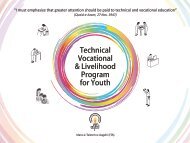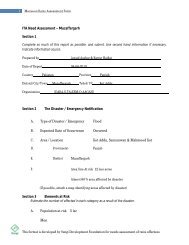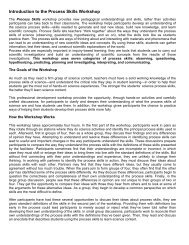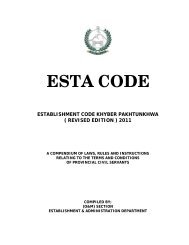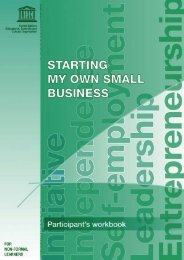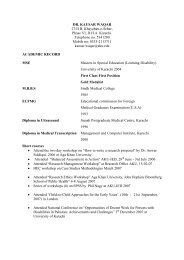Starting my own small business: a training module - unesdoc - Unesco
Starting my own small business: a training module - unesdoc - Unesco
Starting my own small business: a training module - unesdoc - Unesco
- No tags were found...
Create successful ePaper yourself
Turn your PDF publications into a flip-book with our unique Google optimized e-Paper software.
STARTINGMY OWN SMALLBUSINESSA <strong>training</strong> <strong>module</strong> onentrepreneurshipfor learnersin a non-formal settingFacilitator’s guidePart A: Business skillsPart B: Information and communication technology (ICT)
ForewordThe Education For All (EFA) process, for which UNESCO is the leadAgency, has spurred considerable increases in primary schoolenrolments in many Least Developed Countries (LDCs). As theseyoung people complete their primary education, their governments will befaced with the challenge of providing them with opportunities for furtherlearning – either in the form of general secondary education or somepreparation for the world of work.Many countries, particularly in Africa, consider that technicaland vocational education and <strong>training</strong> (TVET) can equip young peoplewith skills that enable them to engage in productive livelihoods. Yet in thepast, TVET programmes have not led to increased employment, despite theobvious need in these countries for technical and vocational services. Thishas been due, in large part, to a dearth of wage employment opportunitiesfor technically trained workers.UNESCO’s Section for Technical and Vocational Educationis addressing this issue by proposing that entrepreneurial skills shouldaugment the technical knowledge and skills learners might already have.Entrepreneurial skills will help them to acquire the mindset and know-h<strong>own</strong>ecessary to make self-employment a viable career option. Since thereis currently little resource material available for teaching and learningabout entrepreneurship, especially for learners in the non-formal setting,UNESCO has developed this prototype of a modular <strong>training</strong> package inentrepreneurship entitled “<strong>Starting</strong> <strong>my</strong> <strong>own</strong> <strong>small</strong> <strong>business</strong>”.It is <strong>my</strong> fervent hope that education authorities, and nongovernmentalorganizations and others will utilize this <strong>training</strong> packagefor non-formal learners in conjunction with vocational skills <strong>training</strong>2
programmes. This can help prepare learners of all ages and backgroundsto have productive livelihoods as self-employed entrepreneurs. In countrieswhere significant numbers of young people work in the informal econo<strong>my</strong>,this resource material may be used to train those already in the workforce tosystematize and improve the quality of their work, with the goal of eventuallybecoming contributors to the formal econo<strong>my</strong>.UNESCO views the ability to engage in a livelihood as a vital lifeskill. Therefore, this <strong>training</strong> package in entrepreneurship may be considereda contribution towards achieving goal 3 of the EFA agenda – providingyoung people and adults with access to quality life-skills programmes.Peter SmithAssistant Director-General for EducationUNESCOParis, March 20063
Preface<strong>Starting</strong> <strong>my</strong> <strong>own</strong> <strong>small</strong> <strong>business</strong> is a prototype modular <strong>training</strong> packagein entrepreneurship that is intended to provide supplementary knowledgeto young people receiving technical and vocational education and <strong>training</strong>(TVET), in formal or non-formal settings, so that they may acquire an entrepreneurialmindset and the knowledge to set up a <strong>small</strong> <strong>business</strong>, if they so wish.The <strong>training</strong> packages have been developed as a result of numerousrequests from high-level education policy-makers in developing countries,particularly in Africa, who have bemoaned the lack of employment opportunities forthe technically trained, while at the same time the availability of technical serviceswas very limited. They were convinced that young technically trained people neededto become self-employed as independent service providers rather than depend onfinding wage employment. Young people would then be able to satisfy the demandfor those services while carving out profitable careers for themselves.Yet, there was little available resource material on entrepreneurship thatcould augment TVET. This led UNESCO to hold two workshops in Lusaka, Zambiaand Kampala, Uganda bringing together TVET policy-makers from 11 East Africancountries to design modular <strong>training</strong> packages in entrepreneurship for higher secondaryTVET learners and for non-formal learners. Following their guidelines andin close consultation with a core group of the workshop participants, UNESCO’sSection for Technical and Vocational Education developed these prototype <strong>training</strong>packages for the two groups of learners.The <strong>training</strong> packages are elementary and are intended to be an introductionto ethical entrepreneurship. They make no claim to be a complete resourcematerial on starting a <strong>small</strong> <strong>business</strong>. Rather, they are core programmes that outlinethe key topics on entrepreneurship and may be expanded or abbreviated asthe teaching situation demands. They also aim at instilling a heightened sense ofself-confidence, particularly among non-formal learners, and awakening them tothe possibility that self-employment could be a viable career option.Launching a successful <strong>business</strong> requires an awareness of one’sknowledge, skills, abilities, aptitudes, values and preferences. The <strong>training</strong> thereforebegins by inviting students to consider their <strong>own</strong> strengths and weaknesses inthese areas, so that they develop a clear sense of themselves. They are encouraged4
to perceive themselves as the actors responsible for their <strong>own</strong> lives. Learners arethen guided through the various stages of developing a commercial idea, fromidentifying a community need for a product or service to acquiring resources,organizing a workplace and marketing the product or service and finally preparinga <strong>business</strong> plan. At each step, the learner is encouraged to discover how his orher skills may be utilized to cater to a need in the community. While encouragingindependent thought, creativity and initiative, the <strong>training</strong> demonstrates thebenefits of collaborative work by treating selected topics as group activities.Finally, a section on the use of information and communication technology(ICT) in a <strong>small</strong> <strong>business</strong> enables facilitators to introduce these concepts to theextent that is relevant. The rapid spread of ICT usage lends this topic increasing significance.Such a discussion may also help to dispel the <strong>my</strong>stique that may persistin the minds of some learners regarding ICT.For learners completing secondary-level education, the <strong>training</strong> may helpto make the transition from the structured atmosphere of the school to the worldof work. For some non-formal learners it may provide the keys to a livelihood andfor others it may lend legitimacy and system to work they are already doing.By promoting economic self-reliance and the need to play a constructiverole in the community, the <strong>training</strong> also aims at human capacity building, akey element of sustainable development. Furthermore, empowering young peopleto engage in productive livelihoods is consistent with the first of the MillenniumDevelopment Goals, which is concerned with poverty eradication.Each <strong>training</strong> package consists of two parts – a facilitator’s guide and aparticipant’s workbook. Facilitators may adapt and interpret the <strong>training</strong> materialto suit the unique situations in each community. The packages may be translatedinto local languages and reproduced without restriction, provided UNESCO isacknowledged as their source.Section for Technical and Vocational EducationUNESCO5
Objectivesof the courseThis package is designed to motivate young and older people whoare not receiving or have not received a formal education. It aimsto equip them with the rudimentary knowledge and skills to engagein some form of self-employment. The units in this package will attemptto create an awareness among the participants of how their <strong>own</strong> qualitiesand latent skills may help them to acquire an entrepreneurial mindset andto launch their <strong>own</strong> <strong>small</strong> <strong>business</strong>.Your role as the facilitator is to help participants to understandthat they must develop attitudes conducive to generating independentinitiatives, using their inherent skills to build livelihoods for themselves.The facilitator must therefore ensure a freely interactive atmosphereand emphasize that participants are full partners in this exercise. Eachparticipant should feel that they can make a crucial contribution towardsthe effectiveness of the course.Practical hintsYour group will be made up of a variety of young people and adultswith different cultural, social and educational backgrounds, some of whommay not be accustomed to the collective learning process of a classroom.Among them, some may have started their <strong>own</strong> <strong>business</strong>. The group shouldbe aware that this diversity is a strength, and that it is important that aclimate of mutual respect be created in the class.Activities should be chosen according to the age, educationallevel and interest of participants. Certain activities may make some adultsfeel that they are being treated like children. Letting them decide if they6
would rather write, draw or just talk could help. Remaining flexible whileensuring that participants acquire specific competencies is a delicate, butimportant skill in a facilitator.Remember: good facilitating is a skill that improves and getsrefined with continued practice.NB. The terms ‘client’ and ‘customer’ are used interchangeably.When either the term ‘product’ or ‘service’ is used, the other is also implied.7
ContentsPART A: BUSINESS SKILLS 9Unit 1 Learning together 10Unit 2 My entrepreneurial skills 11Unit 3 My ideas for <strong>small</strong> <strong>business</strong> 12Unit 4 My market 13Unit 5 Setting <strong>my</strong> prices 14Unit 6 Finding the money to start<strong>my</strong> <strong>business</strong> 16Unit 7 Banking 18Unit 8 Keeping track of <strong>my</strong> money 20Unit 9 Communicating with <strong>my</strong>customers and <strong>business</strong> partners 21Unit 10 Making the best use of <strong>my</strong> time 22Unit 11 Observing rules and regulations 24Unit 12 Managing <strong>my</strong> workplace 25Unit 13 My <strong>business</strong> plan 27PART B: INFORMATION AND COMMUNICATIONTECHNOLOGY (ICT) 29Unit1 Contacting <strong>my</strong> clients andpartners with ICT 30Unit 2 The Internet and e-<strong>business</strong> 32LEARNING OBJECTIVES 348
Business skills9Part AThis part of the course will help participants todiscover the skills and qualities they possess that willassist them to become successful entrepreneurs.It will then introduce them to a few basic conceptsin <strong>business</strong>.
Unit 1Learning together Present yourself to the group. Ask the participants to present themselves.In this unit, you need to encourage participants to share their expectations of thecourse with the rest of the group. This exercise could help to start building confidencein the participants and create an atmosphere of dialogue. Introduce the ultimategoal of the course, which is to create an awareness of their <strong>own</strong> skills and to learnhow to use those skills to engage in a <strong>small</strong> <strong>business</strong>.Discuss: what they expect to discover about themselves what they expect to learn about creating a <strong>small</strong> <strong>business</strong> what they expect to contribute from their experience how they expect to interact with the facilitator and other participants. Ask participants to set ground rules that should be observed during lessons.Encourage them to pay attention to each other’s comments and respect eachother’s opinions. Make a list of these rules and keep them visible throughoutthe sessions.10
Unit 2My entrepreneurial skillsThe diversity in the group of participants is likely to bring together a varied assortmentof skills and prior experiences. However, they may show degrees of reluctance torecognize and discuss their skills.The facilitator needs to be patient in encouraging the participants to articulatetheir capabilities and the value of their experiences, regardless of whether or notthey were acquired in a formal educational setting. It may be worth reminding thegroup that many successful entrepreneurs have received only a modest education.An individual’s inherent talent, combined with initiative and hard work, can producea thriving <strong>business</strong> enterprise.There are different types of skills: conducting <strong>my</strong>self (confidence in <strong>my</strong>self, managing <strong>my</strong> life, being responsible, etc.)thinking (being creative, solving problems, making decisions, observing <strong>my</strong>surroundings, basing actions on needs and opportunities of the immediatecontext, etc.)interacting with people (working with others, accepting others irrespective oftheir cast, gender, social status, whether they have a disability or not, etc.)<strong>my</strong> safety and survival (HIV/AIDS prevention, self-preservation, first aid, drugabuse prevention, etc.) what I can do (repairing bicycles, cooking, making crafts, reading, singing, etc.). Ask participants to describe their skills. Discuss these things: How have they learnt these skills? What do they use these skills for? How often do they have to use the skills? How can they improve their skills?11
Unit 3My ideas for <strong>small</strong> <strong>business</strong> Ask participants to consider their community and identify its needs for productsor services. They could approach this by identifying a difficulty the communityis experiencing and then determining what product or service could helpovercome that difficulty. Ask them whether they can apply one of their <strong>own</strong>skills to provide a service or product that could address the needs.For example: NeedMany elderly people in the community are unable to walk to the market or t<strong>own</strong> centre. What can be done?They need to be provided with a mode of transport. How can I help?I <strong>own</strong> a donkey-cart.I can offer to transport them to the market in <strong>my</strong> donkey-cart for a <strong>small</strong> fee. Ask several participants to generate similar examples. Encourage them to thinkabout their skills and how they may address the identified needs. Ask participants to form <strong>small</strong> groups, each of which will select a need thatthey will develop into a <strong>business</strong> idea as the course progresses. This will alsointroduce the concept of working together in <strong>business</strong>.12
Unit 4My marketBusinesses function by selling a product or service to its market.If a product or service is needed by a person or a group of people, there is a demand.The people who need the product or service, and are willing to pay for it, are customers.The number of customers in the community represents the market for a service orproduct. Businesspeople who provide similar products or services are competitors.A <strong>business</strong> can estimate the size of its market by carrying out surveys of customerneeds, preferences and willingness to pay. Ask participants to design a simple market survey. The survey should try to findanswers to questions such as:1. Who are the people (the part of the community) interested in <strong>my</strong> product(age, gender, income status, etc.)?2. Why do they like or dislike <strong>my</strong> product (shape, size, colour, etc.)?3. Are they willing to pay a commercial price for it?4. Will they always want to buy the product regularly or seasonally(sustainable)? Or will they stop buying it completely (unsustainable)?5. How many of <strong>my</strong> products or hours of <strong>my</strong> service will they need?6. Where should the product be available (location of sales points)?7. Who are <strong>my</strong> competitors?13
Unit 5Setting <strong>my</strong> pricesSince the participants now have an awareness of their talents and skills, and haveshared ideas for possible <strong>small</strong> <strong>business</strong>es, the issue of pricing a product or serviceneeds to be discussed. A product or service may be exchanged for money or foranother product or service.Most <strong>business</strong>es will want to make a profit on products or services sold. Profit is thedifference between the cost price and selling price. Part of this money can be putback (‘re-invested’) into the <strong>business</strong>. Profit should be calculated as a percentage ofthe cost price. The profit margins should always be reasonable.Fixingthesellingpriceofaproductorservicemusttakeintoconsiderationthefollowing: cost of production (including your <strong>own</strong> salary) overheads profit.It is therefore important to accurately calculate each of these, so that the finalselling price is realistic.Cost of production + overheads + profit = selling priceCost of production and overheadsCalculate each component that goes into production and overheads carefully, and addthem up. Labour anddepreciation of equipment (whenequipmentlosesitsvalueovertime)mayalsoneedtobetakenintoaccount.Incalculatingthecostoflabour,theentrepreneurshouldsetawagethatadequatelycompensatestheworkers’knowledgeandcontribution,taking into account the experience and qualifications of the worker, prevailing basic wagerates, holiday pay, government tariffs and social security contributions.Obtaining materials and/or production at a lower price could enable the entrepreneurto reduce the selling price.14
Unit 5Setting <strong>my</strong> pricesProfitThe entrepreneur should set the level of profit made on the sale of a product or servicecarefully, taking into account the relationship between demand for the product (howmany people want it) and the available supply (number of products available to besold). If demand is great for the available supply, the price (and thus the profit) maybe increased. If there is a large supply, but few people want to buy, then prices maydrop. An excessively high price due to a big margin of profit will dissuade customers.When sales increase, profit margins may be reduced. This can enable the entrepreneurto lower the selling price, therefore allowing the <strong>business</strong> to secure the market andeven expand it. Select a product or service. Ask participants to cost the production, overheads(electricity, etc.) as well as factors such as labour and depreciation ofequipment. Ask them to set a profit margin and selling price.Remind participants that the profit earned by <strong>business</strong> may not be retainedin its entirety. The <strong>business</strong> may need to pay taxes to the government or localauthorities.15
Unit 6Finding the money to start <strong>my</strong> <strong>business</strong>People believe that they need a lot of money to launch a <strong>business</strong>. This is not alwaystrue. Talent, resourcefulness and hard work are all as important as money.When we decide to start a <strong>business</strong>, we need to think about what materials we willneed. Different types of <strong>business</strong> require different materials. What a <strong>business</strong> needswill depend on the nature of its activity (the product or service it is providing), and ofcourse its size (how many people it employs, how many clients it has and the amountof goods or services it provides).We should try to obtain the things we need from sources in our community thatwill not require payment. Materials can be expensive, particularly if they have beentransported long distances. Wherever possible, they should be obtained from thelocal community and its surrounding areas. If the necessary materials are not easilyavailable for a reasonable fee, it may be necessary to change the <strong>business</strong> plan slightlyso that we work without that item or work with an alternative item that is similar,or will serve the purpose.We may also need premises to start our <strong>business</strong>.If we need to pay for materials and premises to start our <strong>business</strong>, we will of courseneed some money. We will then need to identify sources from which we will be ableto obtain the money we need.The funds for launching the <strong>business</strong> may be obtained from one or a combination ofsources: personal savings family funds community co-operative organizations community financial syndicates micro-finance organizations post office savings and loan associations banks, etc.16
Unit 6Finding the money to start <strong>my</strong> <strong>business</strong>Loans obtained from banks will involve repayment with interest. A new entrepreneurshould investigate as many sources of funding as possible in order to secure thebest terms and conditions for repayment. This means ‘shopping around’ for the mostfavourable interest rates. Discuss: What materials do we need? Where can we get them? If we have to buy them, how much will we have to pay? From where can we obtain the money?17
Unit 7Banking Describe the different types of bank accounts available in the local community.Cheque (current) accounts and savings accounts are perhaps the most frequentlyused banking services. Other account options are also available, such as fixed depositaccounts.Current (cheque) accountA person can deposit (put in) money into a current account and withdraw (takeout) the amounts needed by writing cheques from a chequebook provided by thebank. Usually there is no charge for withdrawing money, as long as there is sufficientmoney in the account. The bank may also give us a magnetic card, which may beused at that bank’s money-distributing machines. Usually banks do not pay intereston money deposited in current or cheque accounts.Money in a current account may be used to pay the day-to-day costs of running our<strong>business</strong>.Savings accountA savings account is for keeping money that we will not need to use on a day-to-daybasis. The money in a savings account earns interest. That means the bank pays ussome money for leaving our money in the account.We can have both kinds of accounts at any time. When we open a bank account, wemust be sure to keep a record of the amounts of money we deposit (put into) theaccount and the amounts we withdraw (take out of it). If we have a bank accountfor our <strong>business</strong>, it must be a separate account from our personal or family account[trick question in participant’s workbook!].The bank will send us a statement regularly. This lists the amounts of money thathave been deposited and the amounts that have been withdrawn. It tells us howmuch money we have in the account on the day the statement was written. Weshould check that our <strong>own</strong> accounts match the bank’s statement.Our community post office may also provide similar financial services to our bank.18
Unit 7Banking Discuss: Is starting a bank account possible in our community? How would we go about opening a bank account?19
Unit 8Keeping track of <strong>my</strong> moneyIt is important to keep records of all the money earned and all the money spent.The things we need for keeping good records are:a receipt book, for recording each transaction in which the <strong>business</strong> receivesmoneyan expense book, for recording money spenta cashbook, for recording all the money transactions, both amounts received bythe <strong>business</strong> and amounts paid out by the <strong>business</strong>.To ensure that our documents are kept safely and methodically, we should have afiling system. Each type of document should be kept in a separate file (for example,copies of receipts in one file, orders in another file), in alphabetical order. This willhelp us to find the documents we need quickly and easily.Show participants examples of a cashbook, a receipt book and a filing system.20
Unit 9Communicating with <strong>my</strong>customers and <strong>business</strong> partnersCommunicating clearly with customers and <strong>business</strong> partners is extremely importantfor the success of our <strong>business</strong>.A successful entrepreneur is: enthusiastic cheerful polite helpful, etc.Tobuildasuccessful<strong>business</strong>,wewillneedtoconveythefollowingtoourcustomers: “I am honest’Being frank about our product or service can help build clients’ trust and confidencein us. This means that we should not give the client an incorrect impression of ourproduct. Being honest in general may also help us to buy materials or services at areasonable price from our <strong>business</strong> partners. “I have a tidy appearance”Looking clean and tidy will show that we are careful people – and careful about thethings we make or do. “I am courteous”Always be polite and friendly – even if a customer seems rude or does not buyanything. “I listen to <strong>my</strong> customers”Listen carefully and we may find out what a person would really like to buy, or howmuch money they wish to spend. This may help us to suggest an alternative if theydo not find what they want. Divide participants into two <strong>small</strong> groups. Ask one group to play therole of the customer, and the other the role of the service provider inthe <strong>business</strong> of their choosing. Each member of the group should taketurns at being the spokesperson, while the rest of the group generatesideas. Commend innovativeness and tactfully point out shortcomings.21
Unit 10Makingthebestuseof<strong>my</strong>timeAn entrepreneur needs to organize his or her time carefully. Your day may consist ofcarrying out many activities, including family obligations.Managing time is an essential part of good <strong>business</strong> planning, because time is aresource that can have a monetary value. Poor time management usually leads tolast-minute rushes to meet deadlines, stress and inferior performance. This may resultin the product or service not being delivered in time. A disappointed customer mayseek a more reliable <strong>business</strong> provider.Time should be allocated to tasks depending on:when the product or service is to be deliveredhow long the preparation of the product or service is likely to takethe need to co-ordinate people working on the product or service preparationhow important the product or service and client are to the <strong>business</strong> as a whole,etc.Good time management allows for situations beyond our control, such as bad weatherthat may delay our work.Often, we must undertake several tasks at the same time in order to complete our job.We do this by estimating the amount of time necessary for each task and organizingour work accordingly. This is true of many of the activities that we take on in oureveryday lives. For example, when we cook we do not prepare dishes one at a time.Rather, we carry out our chopping, mixing and boiling in such a way that all ourdishes are ready to serve up just when we want them!Similarly, a person working on one task may be asked to help with another task whenthe work situation requires it.The time taken for the various stages of production should be recorded, so thatclients can be given estimates of time before delivery. These records will also beuseful for planning future projects.22
Unit 10Makingthebestuseof<strong>my</strong>time Ask participants to list all the tasks they will have to carry out in their chosen<strong>business</strong> each day. Then ask them to plan how and when they would carry outeach task.For example:Banks are not open for <strong>business</strong> in the late afternoon. Banking operations shouldtherefore be completed in the morning session.Encourage them to co-ordinate activities, so that multiple tasks are carried outat the same time whenever this is possible.23
Unit 11Observing rules and regulationsThe local delivering institution or organization is expected to familiarize theparticipants with the documents referred to in this unit. The aim is to inform theparticipants of the laws, rules and practices that apply when starting a <strong>business</strong> inthe community. These may include, for example: requirements for registering a <strong>business</strong> laws that govern <strong>business</strong>es the tax code for <strong>small</strong> <strong>business</strong>es professional codes of conduct relevant to specific occupations, etc.The authorities may offer certain facilities and incentives to entrepreneurs starting anew <strong>business</strong>. These may take the form of: grants to set up a <strong>small</strong> <strong>business</strong> micro-finance tax relief legal aid recognition in the community, etc.A <strong>business</strong>person from the local community may be invited to discuss with participantshow a new <strong>business</strong> is started. He or she could also describe the unforeseen obstaclesthat are encountered when starting a <strong>business</strong>.This session should be as interactive as possible.24
Unit 12Managing <strong>my</strong> workplaceThis unit introduces basic safety skills to participants and asks them to consider theimportance of productive and safe working environments.A workplace is where goods and services are produced or sold, such as a kitchen,factory floor or shop. Good workplace management helps <strong>small</strong> <strong>business</strong>es to: be efficient create comfortable and safe working conditions gain space reduce material damage and loss (wastage) prevent work-related accidents.Workplaces must be kept clean and safe for workers and clients. The entrepreneurshould pay particular attention to: lighting and ventilation material handling and storage control of hazardous substances.Lighting and ventilationHigh precision work requires appropriate lighting. Workplace windows must thereforebe cleaned regularly to allow sufficient light to come through.Similarly, ventilation is important for good health, particularly where work is beingcarried out with machines, chemicals or raw materials. The work area should allowenough space for air to circulate.Material handling and storageStoring materials properly helps to avoid accidents and save time. Raw materials,semi-finished goods and completed products should be kept in separate areas. Someraw materials and products should not be exposed to the elements (bad weather).They should be stored indoors. Items that are not frequently used should be removedfrom the work area. Appropriate protective equipment should be used, such as glovesand eye protectors.25
Unit 12Managing <strong>my</strong> workplaceControl of hazardous substancesSubstances like organic solvents, paint and glue must be kept in covered containers.Wherever possible, less hazardous materials should be used.Hands should always be washed after handling such substances. Discuss: What is a workplace? Why must a workplace be well-organized and tidy? What must we do to keep our workplace safe?26
Unit 13My <strong>business</strong> planIn this unit, explain that all that has been learnt in the previous units will build intoa <strong>business</strong> plan.A <strong>business</strong> plan is a summary of what the <strong>business</strong> intends to sell, the resources itneeds and how it expects to acquire them, who will manage the <strong>business</strong> and whatprofits may be expected.It is required in order to: obtain permission from the local authority or the Chamber of Commerce to setup the <strong>business</strong> convince funding institutions to provide finance rent a space for <strong>business</strong> premises convince <strong>business</strong> partners to supply materials or services, etc.The <strong>business</strong> plan should consist of the following components:title page (name proposed for the <strong>business</strong>, entrepreneur’s name, contact addressand other co-ordinates)summary of <strong>business</strong> objectivestable of contentsstructure of the proposed <strong>business</strong>intended product or service that is to be soldmarketing plan (based on a simple market survey)financial plananticipated returnsother supporting documents, such as letters of recommendation, certificates ofeducation and <strong>training</strong>, community service documents, etc. Ask participants to form several <strong>small</strong> groups and ask each group to prepare a<strong>business</strong> plan.27
Informationand communicationtechnology (ICT)29Part BInformation and communication technology (ICT)can help to launch and manage a <strong>business</strong> efficiently.Even though certain ICTs may not be immediatelyavailable in many communities, it is important tohave some knowledge of their potential to improveefficiency and expand a <strong>business</strong>. Therefore, wherethe infrastructure to accommodate ICT is not yetin place, the facilitator should take the participantsthrough these units in the interests of generalinformation.This part of the course introduces ICT in aprogressive fashion, starting with the establishedtechnologies and leading to contemporary ones.
Unit 1Contacting <strong>my</strong> clientsandpartnerswithICTICT will enable the entrepreneur to enhance efficiency in the <strong>business</strong> by: facilitating communication storing information tracking inventories of stock providing a medium for advertising.Examples of commonly-used ICTs are given below:PhoneA phone is used for communicating verbally with clients and <strong>business</strong> partners.Fax machineThis is short for ‘facsimile machine’. This is a machine that allows us to transfer a copyof a document through the telephone line. Both the person sending the fax and theperson receiving it need to have a fax machine. Sending a written message by fax isa good way to make sure that it is received as quickly as possible.If we are dealing with people far away, a fax can also be a less expensive means ofcommunicating. A message sent by fax can confirm in writing anything that has beenpreviously agreed on verbally.Most new fax machines also include a phone.RadioRadio is a very effective way to advertise a <strong>business</strong>. It is relatively inexpensive andcan reach a large audience.Some communities have a local radio service. The entrepreneur may use this serviceto advertise products or services by being interviewed during a programme. Thepositive contribution of a <strong>business</strong> to the community can also be publicized via thelocal radio.30
Unit 1Contacting <strong>my</strong> clientsandpartnerswithICTTelevisionA <strong>business</strong> may use the medium of television for advertising. However, it is anexpensive form of advertising.The computerThe computer can be used for:word processing (writing letters or receipts)storing information (financial data, customers’ addresses, etc.)keeping track of inventoriesreminder messages about product or service delivery datesgenerating advertising leaflets and postersgenerating financial statements, etc. Ask participants to carry out exercises as appropriate, taking into considerationthe equipment available and the extent of the participants’ familiarity withthem.31
Unit 2TheInternetande-<strong>business</strong>The InternetThe Internet links computer networks together. To connect to the Internet, we musthave access to the following:a computer with a modem connected to a phone linesoftware that allows us to connect to the Internetan Internet service provider account.The Internet can be used by a <strong>business</strong> in two ways:sending electronic mail (‘e-mail’)accessing the World Wide Web.The Internet is usually available 24 hours a day. This means that communicatingacross different time zones is easy.E-mail enables us to send and receive messages, pictures and sound on our computer.E-mail messages are sent and received almost instantaneously. This is an inexpensiveway to contact people far away, as sending a message may cost about the same as alocal telephone call.The World Wide Web is a part of the Internet that carries millions of pages ofinformation, in sections called websites (sometimes called a homepage). Eachwebsite carries information about a specific <strong>business</strong> or institution and may beupdated regularly by its host or webmaster.A <strong>business</strong> may obtain helpful information by scanning or ‘surfing’ websites. Somewebsites, kn<strong>own</strong> as search engines, can help you to identify other websites and/orinformation of interest. A <strong>business</strong> can launch its <strong>own</strong> website to advertise its productsor services. Advertising via the World Wide Web ensures that the <strong>business</strong> can bepublicized throughout the world. In this way even a <strong>small</strong> <strong>business</strong> can advertise itsproducts worldwide and attract clients who would not otherwise know about them.32
Unit 2TheInternetande-<strong>business</strong>E-<strong>business</strong>E-<strong>business</strong> or e-commerce refers to the process of buying and/or selling by using theInternet to locate the desired product or service, and to discuss payment. One of theadvantages of e-<strong>business</strong> is that geographical distance does not present a problemfor conducting transactions.The client may visit the website launched by a certain <strong>business</strong> and find a productor service that he or she needs. The client then communicates by e-mail with the<strong>business</strong> to order the product or service and to indicate the method of payment. A<strong>small</strong> <strong>business</strong> may find it extremely cost-effective to advertise via the World WideWeb, as launching a website is a relatively inexpensive process.Communicating by e-mail and scanning websites depends very much of course onthe quality and efficiency of the local telephone network and electricity supply. Ask participants to carry out exercises as appropriate, taking into considerationthe equipment available and the participants’ level of familiarity with them.33
34Programme:STARTING MY OWN SMALL BUSINESSBeneficiaries:Duration:Profile:Non-formal learners of all ages and educational backgroundsFlexible. As appropriate to the group of learners. Each unit maybe discussed for at least 1 hour.Programme to be moderated by a facilitator. Instruction and interactive sessionsto be conducted together.Rationale:To help learners to become aware of their <strong>own</strong> knowledge and skills and to develop the acumen to considerentrepreneurship a viable career choice.General objectives:1. Know one’s <strong>own</strong> knowledge, skills, aptitudes and values.2. Understand elementary <strong>business</strong> dynamics.3. Know how to manage a <strong>small</strong> <strong>business</strong>.4. Know how to translate a commercial idea into a <strong>business</strong> plan.5. Know how ICT can be used in a <strong>small</strong> <strong>business</strong>.
35Unit Specific learning outcomes Activities ResourcesGENERAL OBJECTIVE 1: KNOW ONE’S OWN KNOWLEDGE, SKILLS, APTITUDES AND VALUES1. Learning together 1.1 Know how the participant will benefitfrom the programme.1.2 Interact effectively with other participantsand the facilitator.1.3 Develop an interest in knowing aboutand creating a <strong>small</strong> <strong>business</strong>.1.4 Be aware that the participants haveuseful knowledge and experience tocontribute.2. My entrepreneurial skills 2.1 Be aware of the groups of skills requiredfor entrepreneurship.2.2 Know which of these skills they possess.2.3 Be able to communicate how theyhave used these skills.3. My ideas for <strong>small</strong> <strong>business</strong> 3.1 Know how to identify need in thecommunity.3.2 Be able to deduce how to cater to thatneed.3.3 Be able to translate the above conceptinto a practical <strong>business</strong> idea.1A. Self-introductions.1B. Establish ground rules.1C. Discuss previously acquired experiences.1D. Discuss what participants understandby ‘<strong>small</strong> <strong>business</strong>’.2A. Identify different groups of skills.2B. Discuss each individual’s skills andhow they use them.3A. Discuss needs in the community.3B. Generate ideas on catering to thatneed.3C. Form <strong>small</strong> groups to translate theabove ideas into practical <strong>business</strong>concepts.Facilitator’s guide and participant’s workbook.Flipchart/chalkboard.Facilitator’s guide and participant’s workbook.Flipchart/chalkboard.Facilitator’s guide and participant’s workbook.Flipchart/chalkboard.
36Unit Specific learning outcomes Activities ResourcesGENERAL OBJECTIVE 2: UNDERSTAND ELEMENTARY BUSINESS DYNAMICS4. My market 4.1 Understand the concepts of ‘demand’,‘customer’, ‘market’ and ‘competitor’.4.2 Be able to design a simple marketsurvey.5. Setting <strong>my</strong> prices 5.1 Understand the concepts of ‘cost ofproduction’, ‘overheads’ and ‘profitmargin’.5.2 Know how to set prices based onthese concepts.5.3 Understand how supply and demandcan influence price.4A. Interactive discussion on the conceptsof ‘demand’, ‘customer’, ‘market’ and‘competitor’.4B. Guide participants in designing a simplemarket survey by encouraging themto generate novel methods.5A. Explain the concepts of ‘cost ofproduction’, ‘overheads’ and ‘profitmargin’.5B. Discuss setting prices based oncost of production, overheads andprofit margin.5C. Introduce the concept of ‘supply anddemand’.5D. Apply concepts to a local example.Facilitator’s guide and participant’s workbook.Flipchart/chalkboard.Loose paper (to design and carry out thesurvey).Facilitator’s guide and participant’s workbook.Flipchart/chalkboard.6. Finding the money to start<strong>my</strong> <strong>business</strong>6.1 Be able to estimate start-up costs.6.2 Be aware of the possible sources offunding available locally.6.3 Know how to access the various possiblesources.6A. Group sessions on estimating startupcosts for their <strong>business</strong> idea.6B. Discuss possible sources of fundingand their advantages and disadvantages.6C. Explain how to access fundingsources.Facilitator’s guide and participant’s workbook.Flipchart/chalkboard.Local material on funding sources.
377. Banking 7.1 Understand the difference betweencurrent and savings accounts andtheir uses.7.2 Know the basic steps required foropening and managing a bank account.7.3 Know the importance of keepingpersonal and <strong>business</strong> accountsseparate.7A. Explain the difference between currentand savings accounts.7B. Introduce the steps involved in openingand managing an account.7C. Emphasize the importance of keepingpersonal and <strong>business</strong> fundscompletely separate.Facilitator’s guide and participant’s workbook.Flipchart/chalkboard.Loose paper (to design and carry out thesurvey).GENERAL OBJECTIVE 3: KNOW HOW TO MANAGE A SMALL BUSINESS8. Keeping track of <strong>my</strong> money 8.1 Know the functions of a receipt book,expense book and cashbook.8.2 Understand the importance of a filingsystem.8A. Introduce the functions of a receiptbook, expense book and cashbook.8B. Guide participants in filling in a receiptdocument, expense book and cashbook.8C. Highlight the advantages of an organizedfiling system.8D. Demonstrate a simple filing system.Facilitator’s guide and participant’s workbook.Flipchart/chalkboard.Examples of a receipt book, cashbook andexpense book.9. Communicating with <strong>my</strong> customersand <strong>business</strong> partners9.1 Be aware of the importance of effectivecommunication.9A. Discuss the importance of effectivecommunication in <strong>business</strong>.Facilitator’s guide and participant’s workbook.9.2 Know how effective communicationcan help a <strong>business</strong>.9B. Discuss how communication canhelp in <strong>business</strong>.Flipchart/chalkboard.9.3 Be able to articulate a simple <strong>business</strong>proposition.9C. Guide participants in role-playing<strong>business</strong> scenarios.
38Unit Specific learning outcomes Activities Resources10. Making the best use of <strong>my</strong>time10.1 Be aware that in <strong>business</strong>, time ismoney.10A. Introduce the concept that time ismoney in <strong>business</strong>.Facilitator’s guide and participant’s workbook.10.2 Understand the concept of timemanagement.10.3 Be able to carry out multiple tasks ina time-coordinated manner.10.4 Understand that efficiency is crucialfor the sucess of the <strong>business</strong>.10B. Discuss time management.10C. Guide participants in role-playingthe co-ordination of multiple tasks.10D. Discuss the importance of efficiency.Flipchart/chalkboard.Clock if available.11. Observing rules and regulations11.1 Know local rules and practices governingthe start-up and managementof a <strong>small</strong> <strong>business</strong>.11.2 Be aware of benefits and incentivesoffered locally to entrepreneurs andnew <strong>small</strong> <strong>business</strong>es.11A. Explain local rules and practicesgoverning the start-up and managementof <strong>small</strong> <strong>business</strong>es.11B. Discuss benefits and incentives offeredlocally.11C. Invite a local entrepreneur to discussopportunities and challenges in startinga <strong>small</strong> <strong>business</strong>.Facilitator’s guide and participant’s workbook.Flipchart/chalkboard.Copies of rules and regulations as appropriate.Copies of other documents as necessary.12. Managing <strong>my</strong> workplace 12.1 Understand the concept of a workplaceas separate from a living space.12.2 Be aware of the importance of an organizedand safe workplace.12.3 Be methodical and able to implementbasic safety measures in theworkplace.12A. Introduce the concept of ‘the workplace’as opposed to a living space.12B. Discuss the importance of an organizedworkplace.12C Discuss how to organize the workplaceand implement safety precautions.Facilitator’s guide and participant’s workbook.Flipchart/chalkboard.Any locally-available industrial safety material(pamphlets, brochures, etc.).
39GENERAL OBJECTIVE 4: KNOW HOW TO TRANSLATE A COMMERCIAL IDEA INTO A BUSINESS PLAN13. My <strong>business</strong> plan 13.1 Understand why a <strong>business</strong> plan isnecessary.13.2 Know the information that constitutesthe <strong>business</strong> plan.13.3 Be able to draft a simple plan forone’s <strong>own</strong> <strong>business</strong>.13A. Explain why a <strong>business</strong> plan is necessary.13B. Discuss the information that constitutesthe <strong>business</strong> plan.13C. Guide groups of participants indrafting a <strong>business</strong> plan.Facilitator’s guide and participant’s workbook.Flipchart/chalkboard.Examples of <strong>business</strong> plans.GENERAL OBJECTIVE 5: KNOW HOW ICT CAN BE USED IN A SMALL BUSINESS1B. Contacting <strong>my</strong> clients andpartners with ICT1B.1 Be aware of how ICT can help a<strong>small</strong> <strong>business</strong>.1B.A Discuss how locally-available ICTscan help a <strong>small</strong> <strong>business</strong>.Facilitator’s guide and participant’s workbook.1B.2 Be familiar with the traditional andmodern ICTs used in <strong>small</strong> <strong>business</strong>.1B.3 Know the functions a computer canperform.1B.B Discuss traditional and modern ICTs.1B.C Discuss how a computer can help a<strong>small</strong> <strong>business</strong>.1B.D Demonstrate examples of locallyavailableICTs.Flipchart/chalkboard.Locally-available ICTs as appropriate.2B. The Internet and e-<strong>business</strong> 2B.1 Know the potential of the Internetfor a <strong>small</strong> <strong>business</strong>.2B.2 Understand how e-mail can help a<strong>small</strong> <strong>business</strong>.2B.3 Be aware of the potential of e-<strong>business</strong>.2B.A Discuss the potential of the Internetfor a <strong>small</strong> <strong>business</strong>.2B.B. Discuss how e-mail can help a <strong>small</strong><strong>business</strong>.2B.C. Discuss the potential of e-<strong>business</strong>.Facilitator’s guide and participant’s workbook.Flipchart/chalkboard.Computer linked to the Internet if availablelocally.


